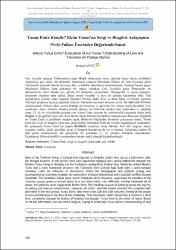| dc.contributor.author | Aycil, Serkan | |
| dc.date.accessioned | 2023-09-04T10:53:26Z | |
| dc.date.available | 2023-09-04T10:53:26Z | |
| dc.date.issued | 30.11.2021 | en_US |
| dc.identifier.citation | Aycil, S. (2021). Yunus Emre Kimdir? Bizim Yunus’un Sevgi ve Hoşgörü Anlayışının Posta Pulları Üzerinden Değerlendirilmesi . Afyon Kocatepe Üniversitesi Sosyal Bilimler Dergisi , Yunus Emre ve Türkçe Özel Sayısı , 155-168 . DOI: 10.32709/akusosbil.987914 | en_US |
| dc.identifier.uri | https://dergipark.org.tr/tr/pub/akusosbil/issue/65941/987914 | |
| dc.identifier.uri | https://hdl.handle.net/11630/10574 | |
| dc.description.abstract | Orta Asya'da yaşayan Türkmenlerin çoğu Moğol istilasından sonra, güvenli liman olarak gördükleri Anadolu'ya göç ettiler. Bu dönemde Anadolu'da yaşayan Müslüman Türkler ile Orta Asya'dan gelen Türkmenler arasında önemli derecede dini ve kültürel farklılıklar bulunmaktaydı. Yerleşik hayata geçen Müslüman Türkler, daha gelenekçi bir yapıya sahipken, Orta Asya'dan gelen Türkmenler ise Şamanizm’in etkisi altında yarı göçebe bir zihniyetle yaşıyorlardı. Demografik ve siyasi değişime, ekonomik sıkıntılar eşlik edince, huzur ortamı bozuldu ve olası bir çatışma kaçınılmaz oldu. Tüm kaynaklarını seferber eden Anadolu Selçuklu Devleti, Baba İlyas ve Baba İshak çevresinde toplanan Türkmen grupların isyanını güçlükle bastırdı. Gücünün tamamını tüketen otorite, bir daha eski formunu yakalayamadı. Ortaya çıkan otorite boşluğu ise huzursuz ve güvensiz bir ortama zemin hazırladı. Eski cazibesini yitiren Anadolu, bundan sonraki süreçte, bir birbiriyle rekabet eden toplumlara ev sahipliği yaptı. 13. ila 14. yüzyıllarda yaşamış olan Yunus Emre yaşanan bu istikrarsızlık karşısında bütün halkı sevgiye ve hoşgörüye davet etti. Kısa sürede ekole dönüşen bu hareket Anadolu’nun dokusunu değiştirdi ve Yunus Emre’yi gönüllerin odağına taşıdı. Bütün bu bilgilerden hareketle çalışmanın amacı; Yunus Emre'nin sevgi ve hoşgörü anlayışını, posta pulları üzerinden farklı bir formda kurgulamaya çalışmaktır. Bu çalışmada Yunus Emre’nin yaşam felsefesini oluşturan; insan faktörü, Türk dili vurgusu, dünya yaşantısı, terkler, gönül güzelliği, sevgi ve hoşgörü konularına da yer verilmiştir. Çalışmada toplam 10 adet görsel kullanılmıştır. Bu görsellerin 9’u pullardan 1’i ise özelgün zarfından oluşmaktadır. Çalışmanın, bilimsel nitelikli araştırmalara kaynak teşkil edeceği düşünülmektedir. | en_US |
| dc.description.abstract | Most of the Turkmen living in Central Asia migrated to Anatolia, which they saw as a safe haven, after the Mongol invasion. In this period, there were significant religious and cultural differences between the Muslim Turks living in Anatolia and the Turkmens coming from Central Asia. While the settled Muslim Turks had a more traditional structure, the Turkmens from Central Asia lived with a semi-nomadic mentality under the influence of Shamanism. When the demographic and political change was accompanied by economic troubles, the atmosphere of peace deteriorated and a possible conflict became inevitable. The Anatolian Seljuk State, which mobilized all its resources, suppressed the rebellion of the Turkmen groups gathered around Baba İlyas and Baba İshak with difficulty. Having exhausted all its power, the authority never regained its former form. The resulting vacuum of authority paved the way for an uneasy and insecure environment. Losing its old charm, Anatolia hosted societies that competed with each other in the next period. Yunus Emre, who lived in the 13th and 14th centuries, invited all the people to love and tolerance in the face of this instability. This movement, which turned into a school in a short time, completely changed the texture of Anatolia and brought Yunus Emre to the center of hearts. Based on all this information, the aim of the study is; Trying to reinterpret Yunus Emre's understanding of love and tolerance through postage stamps. In this study, Yunus Emre's philosophy of life; human factor, emphasis on Turkish language, world life, abandonment, beauty of heart, love and tolerance. A total of 10 images were used in the study. 9 of these images consist of stamps and 1 of them consists of a special day envelope. It is thought that the study will be a source for scientific researches. | en_US |
| dc.language.iso | tur | en_US |
| dc.publisher | Afyon Kocatepe Üniversitesi | en_US |
| dc.identifier.doi | 10.32709/akusosbil.987914 | en_US |
| dc.rights | info:eu-repo/semantics/openAccess | en_US |
| dc.subject | Yunus Emre | en_US |
| dc.subject | Sevgi ve Hoşgörü | en_US |
| dc.subject | Posta Pulu | en_US |
| dc.subject | Terkler | en_US |
| dc.subject | Love and Tolerance | en_US |
| dc.subject | Postage Stamp | en_US |
| dc.subject | Stamp | en_US |
| dc.subject | Abandonments | en_US |
| dc.title | Yunus Emre kmdir? Bizim Yunus’un sevgi ve hoşgörü anlayışının posta pulları üzerinden değerlendirilmesi | en_US |
| dc.title.alternative | Who is Yunus Emre? Evaluation of our Yunus’ understanding of love and tolerance on postage stamps | en_US |
| dc.type | article | en_US |
| dc.relation.journal | Afyon Kocatepe Üniversitesi Sosyal Bilimler Dergisi | en_US |
| dc.department | Seçiniz | en_US |
| dc.authorid | 0000-0002-3540-5548 | en_US |
| dc.identifier.volume | 23 | en_US |
| dc.identifier.startpage | 155 | en_US |
| dc.identifier.endpage | 168 | en_US |
| dc.identifier.issue | Yunus Emre ve Türkçe Özel Sayısı | en_US |
| dc.relation.publicationcategory | Makale - Ulusal Hakemli Dergi - Başka Kurum Yazarı | en_US |



















